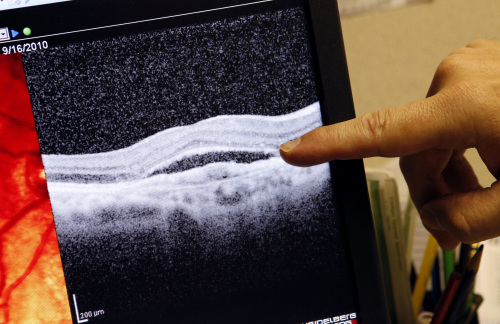DALLAS ― Jennifer Tyler was driving down a country road in Oklahoma a couple of years ago when she noticed something odd. The telephone poles all had kinks in them.
“I thought, ‘Wow, what’s all that about?’” says Tyler, a Dallas fundraising consultant. “They all had distinctive bends in the middle.”
She pulled off the road and called a friend. “I knew something bad was happening,” she says. “It was nothing I could ignore.”
Her friend referred Tyler to Texas Retina Associates. Tyler made an appointment and was diagnosed as having age-related macular degeneration.
AMD is a disease that causes significant vision loss in 1.75 million Americans. More than 10 million suffer from various forms of this potentially sight-stealing disease, more than glaucoma and cataracts combined, according to the American Macular Degeneration Foundation.
By 2020, as the population ages, that number is expected to double.
In addition, says Dr. Karl Csaky (pronounced like chalky) of the Retina Foundation of the Southwest, “more severe forms will be more of an issue.”
“People who are in their 70s and 80s are extremely active,” says Csaky, head of the foundation’s Harrington Molecular Laboratory and an ophthalmologist with Texas Retina Associates. “If you had even a relatively small disturbance in vision, that could be extremely devastating in terms of what you’re used to doing.”
Some vision disturbances, such as difficulty reading small print, are inherent with aging. The lenses of our eyes change and can no longer focus close up, so we rely on reading glasses.
“I thought, ‘Wow, what’s all that about?’” says Tyler, a Dallas fundraising consultant. “They all had distinctive bends in the middle.”
She pulled off the road and called a friend. “I knew something bad was happening,” she says. “It was nothing I could ignore.”
Her friend referred Tyler to Texas Retina Associates. Tyler made an appointment and was diagnosed as having age-related macular degeneration.
AMD is a disease that causes significant vision loss in 1.75 million Americans. More than 10 million suffer from various forms of this potentially sight-stealing disease, more than glaucoma and cataracts combined, according to the American Macular Degeneration Foundation.
By 2020, as the population ages, that number is expected to double.
In addition, says Dr. Karl Csaky (pronounced like chalky) of the Retina Foundation of the Southwest, “more severe forms will be more of an issue.”
“People who are in their 70s and 80s are extremely active,” says Csaky, head of the foundation’s Harrington Molecular Laboratory and an ophthalmologist with Texas Retina Associates. “If you had even a relatively small disturbance in vision, that could be extremely devastating in terms of what you’re used to doing.”
Some vision disturbances, such as difficulty reading small print, are inherent with aging. The lenses of our eyes change and can no longer focus close up, so we rely on reading glasses.

Macular degeneration goes beyond the normal aging process. It affects the center of the retina; specifically, the 0.1 percent that’s responsible for 99.9 percent of our fine vision, Csaky says.
“Unfortunately,” Csaky says, “the central part is what gives you quality of life, the ability to read, drive, play golf, to discern faces.”
He uses the analogy of a camera to explain the difference between normal eye aging and macular degeneration.
“The lens of the eye is like the lens of a camera,” he says. “Cataracts are when the lens of the camera gets cloudy and the picture gets fuzzy. The solution? Change your lens, which is what cataract surgery is.
“In macular degeneration, your film has gotten old. We can change lenses, put in a special lens, and still have a bad picture because the film is starting to decay.“
Macular degeneration has no cure, but those involved in studying and treating it point out glimmers of hope:
Though it may cause legal blindness, rendering some victims unable to drive or read, it won’t cause total blindness.
Most kinds never progress past the initial stage. Diagnosis is not “a death sentence for vision,” Csaky says.
Treatments can slow down and sometimes reverse the more severe cases of the condition.
Diagnostic tools can catch it in its early stages.
To check for it, “We dilate your eyes, use a lens and look for yellow spots (drusen) or pigmentation changes or bleeding,“ says Dr. Yuguang He, associate professor of ophthalmology at the University of Texas Southwestern Medical Center and a specialist in age-related macular degeneration. “It’s not like it takes a blood test or X-ray to diagnose. We just look at it.”
The sooner it’s found, the better, he says. “There is a window in which we can do treatments.”
Most treatments are geared toward the more advanced form called wet macular degeneration. The early stage is called dry, which can progress to late-severe dry and sometimes lead to wet.
Progression from the dry form to wet can be rapid. Tyler went to a doctor when she first had symptoms, so he was able to diagnose the disease early. Thus, she’s been able to receive a relatively new and often successful treatment: a monthly shot directly into each of her eyes.
Although there is no surefire way to prevent the disease, studies have shown that eating fish two or more times per week helps reduce the risk, he says. “I take fish oil. I’m 54 years old and take it not only to prevent AMD but also to protect my heart, help my cholesterol. I tell patients, something good for your heart has to be good for your eyes.”
He also points out the Age-Related Eye Disease study of the National Eye Institution. Participants took large quantities of vitamins A and C, as well as zinc, copper and beta carotene. The regimen neither prevents the disease nor, in the study, did it have any effect on the dry form, but it “slowed the progression of the wet variety by 20 percent,” he says.
Tyler, who declined to give her age, manages her ailment as best she can, getting injections and participating in a study. She is constantly aware of her surroundings, on the lookout for any line in a grid that appears curvy or wavy. She checks the spindles on her staircase, “whatever’s around me,” for possible distortion.
“It was never even in my mind, as driven and focused as I am in my career, that I wouldn’t be responsive to it,” she says. “It’s your vision for heaven’s sake. How scary is that?
“You can work with it and make it a positive thing, or it can devastate you. You make these choices in life. What am I going to do about it? Is it going to define me, or am I going to help define it?”
Age-related macular degeneration (AMD) is the No. 1 cause of irreversible vision loss among senior citizens, according to the Retina Foundation of the Southwest. Some risk factors:
Caucasians are more likely to contract AMD than other races.
“If you’re a Caucasian older than 65, there’s a 20 percent chance you’ll get it,” says Dr. Yuguang He, associate professor of ophthalmology at UT Southwestern Medical Center. “If you’re Chinese or Japanese, less than 5 percent. African-Americans have it much less than Caucasians.”
Yet, “as the Japanese adopted our diet, their incidence has gone up,” says Dr. Karl Csaky of the Retina Foundation of the Southwest and Texas Retina Associates.
Smoking increases incidence.
“Cigarette smokers are 20 times more likely to develop AMD than nonsmokers,” he says. “The chances are very, very high.”
If one eye is affected, the other eye will be, too.
It’s important to periodically cover up the eye that has it to see whether the other eye is seeing distortions, too.
Genetics play a factor.
“If your parents have it, there’s an increased risk you’ll get it, but it’s not a guarantee,” he says. “We’re still struggling with the practical implications of these genetic associations other than scaring people.”
By Leslie Barker Garcia
(The Dallas Morning News)
(McClatchy-Tribune Information Services)


















